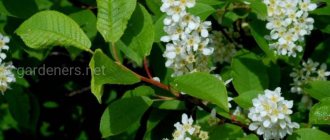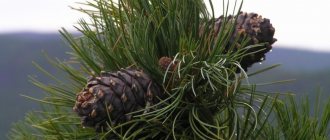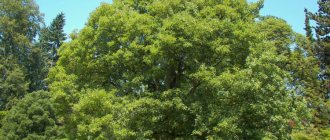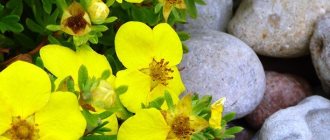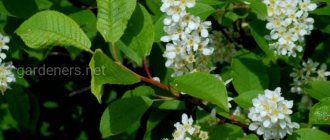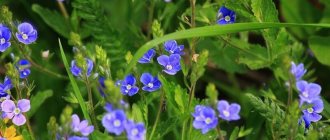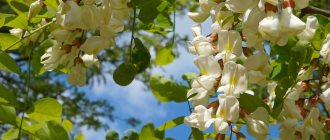It was about this variety of maple that many poems were written. It is called the sycamore tree because of the legend of the ancient Slavic tribes. They believed that it was in it that the human soul was imprisoned. Therefore, it is not used for fuel or heating. It cannot be used to cut coffins.
Serbs believe that he senses the purity of the soul of every person. If a hand with pure thoughts touches it, it will begin to bloom. If a person’s soul is unclean, then the tree will begin to dry out and rot.
Why is the false sycamore maple called sycamore?
According to the legends of the ancient Slavs, a person was turned or “sworn” into this tree. Therefore, maple is never used to heat a stove, nor is it used to make coffins, considering it a great sin to place living people in the ground.
A man turned into a sycamore because of a mother’s curse on her disobedient children. When the musicians pass by a maple tree, they cut it down and make a violin. Its sounds, in the voices of children, tell how their mother committed a crime in front of them.
The Serbs have a different belief. A dry maple tree will turn green if it is hugged by a person who has been wronged unfairly. And, conversely, a green maple will dry out if a deeply unhappy or offended person touches it.
Selection of seedlings
The future condition of the tree is influenced by the seedling you choose to plant. It is better, of course, to purchase seedlings from a nursery. Some gardeners believe that it is better to choose a seedling that is more than four years old, because it will take root faster. But it is not always the case. For example, very young plants can have a root system many times better than an older one. This is due to the fact that seedlings for nurseries are not pulled out manually, but using machinery. Naturally, in the process of digging up the roots of an already grown seedling may be more damaged.
What to consider when purchasing planting material:
- buy a seedling in September–October;
- pay attention to the leaves and roots: they must be in perfect condition.
White maple, or sycamore
This tree from the maple genus is common in Europe - the central part, in Asia - in the southwest. The growing area covers France, Ukraine, northern Spain, Turkey, and the Caucasus.
False sycamore maple (sycamore) is a deciduous tree. Its height reaches twenty to thirty-five meters. The wide crown has a dome shape. The trunk bark of trees in the first years of life is smooth, with a gray tint. In mature trees it is rough, its scales flake off. The layers of bark with a different color are clearly visible: pale brown and pinkish.
The leaves are large, identical in size, both in length and in width - from ten to twenty-five centimeters. They consist of five blades. Their edges are jagged. The color is dark green, purple, crimson, yellowish, depending on the season. The yellow-green flowers are collected in hanging racemes up to twenty centimeters long. There are many flowers in the inflorescence, from twenty to fifty pieces.
The seeds, arranged in pairs, have a spherical shape, in the form of a lionfish. Each seed is endowed with small wings, thanks to which it flies when it falls. The wind carries the seeds over long distances.
The false sycamore maple, the photo of which you see in the article, is a strong tree. But it is also susceptible to the appearance of spots of different colors on the leaves: black, gray, brown. These are pathogenic fungi. Maple leaves are a breeding ground for lepidopteran insects.
Description of the plant
Steppe mushrooms of Crimea photo and description. description and names of Crimean mushrooms (+27 photos)
Belongs to the maple genus. Grows in France, Europe and Asia. It grows up to 35-40 m. The crown independently forms in the shape of a dome. The bark is pale gray-brown or pinkish. The crown in diameter can exceed 1-1.3 m.
The emerald-colored leaves are large in size. Serrated along the edge, they are divided into 5 blade sections. The plates are lobed-fingered. Long petioles reach 25-30 cm in length. In autumn, all the foliage turns a bright yellow shade; this is also typical for yellow maple.
The hanging clusters of inflorescences are yellow-green. The flowering is lush. Each inflorescence contains from 25 to 45 flowers.
In early autumn, the fruits ripen in the form of green lionfish. Towards the end they become brown, reddish. They dry out and are easily carried away by gusts of wind, or fall to the ground. At the beginning of each lionfish hides a seed that will sleep in the ground all winter. It will bloom only at the beginning of spring.
Application and use of the plant
The variety is well known to furniture manufacturers due to its properties. Its dense and smooth texture allows you to create masterpieces that will last for centuries. Its density is equivalent to oak. The furniture turns out to be a noble light color with a barely noticeable texture and shine.
However, the breed has its drawbacks. It must be treated with antiseptics. It is susceptible to insect attack.
Honey and musical instruments
In addition to furniture, maple is used to make musical instruments, parquet floors and various accessories. If fibers are visible in a section of wood, the cost of the product immediately increases. White maple is a unique honey plant. The product comes out very aromatic and sweet.
Landscape design
Wood is often used in landscape design, especially in the USA and Europe. There are more than a hundred species and varieties known in nature that perfectly diversify and decorate the garden. They love to landscape not only home gardens, but city streets and coastal areas.
Medicine
The seeds and leaves are used as medicine. They are dried in the oven or in the sun. Store under glass. Decoctions help with tuberculosis and colds.
There are wild maples that grow on coasts and forests. Their leaf plate is larger in size. And the height exceeds 35-40 m.
Types and varieties of maple
Maple is truly diverse in its varieties and types. There are different shapes, sizes of crowns, leaves and even bark.
Atropurpureum
A deciduous tree grows slowly. Can live more than 100-110 years. The 5-lobed leaves make up a dense oval crown. The inner side of the leaf is painted in a lilac shade. The tree does not reach more than 5 m in height.
The fruits are formed in early autumn, also in the form of a lionfish. This shrub is often used to plant hedges in city flower beds. The plant is not afraid of gas pollution and retains oxygen well.
Leopoldi
Leopoldi easily grows up to 15 m in height. The crown has the shape of a pyramid. The leaves are divided into 5-6 lobes. The uniqueness of the variety lies in the color of the leaf blade. From late summer to early autumn it becomes covered with yellow spots. The inflorescences are painted crimson. Feels good both alone and in group compositions.
Red
One of the most beautiful varieties is named after its red foliage. The crown is formed in the shape of a pyramid. Grows up to 15 m in height. The plant will become an excellent center of any landscape composition. Even one tree at the entrance can change the appearance of the entire house.
Holly
Norway maple has a lush and dense crown. The leaves have a pointed edge. Divided into several blades. Inflorescences appear in early spring. They are colored yellow and yellow-green.
Golden variegated ash maple
It grows only 7 m in height. It can be propagated by seeds, cuttings and even grafting. Withstands frosts, showers and strong gusts of wind. Large green leaves are divided into lobes. The emerald green color of the plate is diluted with lemon yellow spots along the edge of the sheet.
What is it grown for and where is it used?
False sycamore maple is valued for its wood. The description of the sycamore variety is given according to the characteristics of the wood. It is white, silky, shiny, and highly wear-resistant. White maple wood is used to produce furniture, fittings, musical instruments, flooring, and parquet. Sometimes the wood has a fibrous texture, which greatly increases its value. It is used for facing work.
White maple is a good honey plant. Its flowers produce nectar and pollen in abundance - raw materials for processing by bees, resulting in aromatic honey.
White maple in landscape design
This tree is resistant to strong gusts of wind, air pollution and salt. Therefore, it is popular for landscaping urban areas, roadsides, and sea coasts. Currently, maple is distributed north of its habitat in Scandinavia and the British Isles.
Throughout North America, wild white maples can be found in New York, New England and along the western Pacific coast. Trees are grown as a crop in many regions characterized by a temperate climate: for example, New Zealand, the Falkland Islands.
Application
Sycamore is a fast-growing species that is resistant to atmospheric pollution, including dust, industrial gases and heavy metal salts. Thanks to its large foliage, it perfectly purifies the air, releasing large amounts of oxygen. This tree is suitable for landscaping streets, parks and squares.
Sycamore wood is highly durable. The density of the dry mass is about 650 kg/m3, which is only slightly less than that of oak. This is a light, almost white material with a discreet texture, straight fibers and a silky sheen. It is easily processed with all types of tools, polished, and holds varnishes and paints. It is used for the manufacture of furniture, flooring, finishing panels, veneer, musical instrument bodies, various carpentry, decorative dishes and souvenirs. Maple is not bioresistant; to prevent rapid decay, this material must be treated with antiseptics.
Honey plant
The flowers produce pollen and nectar in abundance, producing aromatic, mild-tasting, pale-colored honey. Nectar production is less abundant than from Norway maple.
White maple in garden and park culture
White maple is remarkable for its resistance to wind, urban pollution and salt, making it popular for growing in cities, along roads salted in winter, and on the sea coast.
It is introduced and widely distributed in cultivation north of its native range in northern Europe, especially the British Isles and Scandinavia, as far north as Tromsø in Norway (seeds may ripen as far north as Vesterålen), Reykjavik (Iceland) and Tórshavn in the Faroe Islands .
READ Cypress - stylish garden decoration
Typical tree
In North America, wild (originating from cultivated plantings) white maples are common in New England, New York, and the Pacific Northwest.
Grown in many temperate parts of the Southern Hemisphere, very common in New Zealand and the Falkland Islands. It is considered an unwanted invasive weed in some parts of Australia (Yarra Ranges, Victoria).
The popular cultivar Acer pseudoplatanus 'Brilliantissimum' is remarkable for its vibrant orange-pink young foliage.
Maple Atropurpureum
This variety of false sycamore maple is a deciduous, slow-growing tree. Reaches twenty-five meters in height and twelve in diameter. The dense crown has an oval shape. The leaves consist of five lobes. Their upper part is dark green and the lower part is dark purple. Young leaves attract the eye with a red-brown hue. Flowering period is May. Yellow-green flowers are collected in brushes. The fruit is wing-shaped and is called lionfish.
Article on the topic: Willow tristamen - useful properties, description
False sycamore maple Atropurpureum loves a lot of light, but can also grow in the shade. Does not tolerate overly moist, dry and saline soils. Prefers fertile soil with good drainage. Due to its high decorative qualities, it is used for landscape design: creating hedges, arrays, groves. The tree is adapted to dust and gas pollution. It tolerates winters well, but in extreme cold it needs shelter to avoid freezing.
Care
You need to take care of the white maple, since you are planting it on your site for decorative purposes.
- Water the plant regularly. Abundant watering is a guarantee that the plant will not lose its decorative qualities. In spring and autumn, water the maple once a month with 15–20 liters of water. In summer you need to increase the amount up to four times. But the planted plants need to be watered with even more water: from 40 liters or more.
- After watering, immediately loosen the soil.
- Remove weedy plants.
- Feed the plantings once a year. There is no need to fertilize in the first year, because you have already applied fertilizer to the planting hole. But after a year, add fertilizers: superphosphate, potassium salts or urea.
- Trim dead, damaged or diseased branches.
Leopoldi maple
This tree reaches a height of ten to fifteen meters. Its wide crown has a pyramidal shape with a diameter of eight meters. The leaves are large, rich green. Uneven spots in the form of sectors and inclusions of white, cream or light green color are clearly visible on the surface, which acquire a yellow tint in autumn. Flowering time is in April. The flowers are small, reddish in color. The winged fruits are brown in color.
Grafted maples are more common; their height depends on the height of the trunk. Leopoldi is distinguished by its decorativeness, especially in spring. Trees are planted individually and in groups. Landscape compositions and alleys are created from them.
False sycamore maple Leopoldi loves a lot of light, but also grows in the shade on any soil except overly moist, dry and saline. Propagated by seeds and cuttings. Does not tolerate winters with severe frosts and may freeze. It will develop poorly and lose its decorative effect. Therefore, this species shows all its best qualities to a greater extent, growing in areas with a warm climate.
Growing
This plant loves light and warmth. Therefore, choose a sunny location with fertile soil to plant a young white maple tree. But for several years after planting you will need to shade the seedlings, otherwise they will lose their decorative effect.
Source: Depositphotos
You need to prepare the planting site 2-3 weeks before planting the white maple.
Dig a planting hole 50x70 cm in size and add a mixture of soil and humus to it. In general, it depends on the variety and type of maple which fertilizers need to be added and in what quantities. So focus on these characteristics. Young trees should be planted at a distance of 2–4 m from each other. But if you want to create a hedge of trees, then reduce the distance to two meters.
Do not bury the plant when planting - the root collar should be at soil level. During watering, the soil itself will settle by 15–20 cm. If the groundwater level is low in the area, then pour crushed stone into the planting hole.
Only the planted white maple needs to be watered frequently and abundantly. In hot weather - once a week. Water should saturate the ground to 50 cm.
Usage
One hundred and fifty species of maple grow in the natural environment, most of which, including the false sycamore maple, are widely used in the design of territories. This tree is highly decorative at any time of the year. In spring, the long flowering and bright colors of young shoots are pleasing to the eye, in summer there is a lush crown, under the shadow of which you can hide from the sun. In autumn, nature itself repaints the leaves in different colors. In winter, the unusually colored bark attracts attention. Maple trees are planted individually and in groups to form a hedge. The crown can be formed into any shape.
Maple wood is used to make furniture, sports equipment, musical instruments, and yellow and black paint. Maple is an excellent honey plant. Pollen collected from one tree, when processed by bees, produces ten kilograms of honey. Maple produces sap, which is used to make sugar syrup and sugar. The leaves are used for livestock feed and bedding.
Sycamore, white maple or false sycamore medicinal properties
Sycamore, white maple or false sycamore (Acer pseudoplatanus) is a plant from the Maple family. It is found in the Caucasus, western Europe and the northern coast of Asia Minor. Sycamore is cultivated mainly in the European part of our country. White maple is a strong deciduous tree up to 30 -40 m in height, with brown-gray bark and five-lobed, rounded, heart-shaped leaves. The crown has a dome-shaped shape. The leaves are dark green on top and whitish or bluish below. The leaves are opposite, up to 25 cm in length, the petioles are quite long - from 5 to 15 cm. Yellowish-green small (up to 8 mm in diameter) sycamore flowers are collected in long spike-shaped racemes up to 16 cm long, which droop over time. It takes up to six months for the fruit to ripen. The fruit is a lionfish, diverging at right angles. The wings allow the seeds to fly by rotating with the wind. This helps the seeds travel a considerable distance from the parent tree. Sycamore, white maple or false sycamore in folk medicine Leaves, tree sap and bark are used for medicinal purposes. The leaves contain wax and cerotic acid. Freshly fallen leaves contain fat, fiber and protein. The juice from the leaves is used as a diuretic. The bark contains pectin, organic acids and polysaccharides. A decoction of the bark is used as an astringent for diarrhea. Maple sap was widely used in folk medicine as an astringent, as well as for bladder diseases, scurvy and as a diuretic. Maple sap is also used to produce maple syrup and a sugar substitute.
Article on the topic: Bladder sedge - beneficial properties, description
False sycamore maple is a good honey plant and ornamental plant. Therefore, white maple is often found in gardens and vegetable gardens. When growing it, you need to remember that maple does not like waterlogging and prefers a sunny place.
Traditional medicine is indispensable in the treatment of female diseases, such as mastopathy, breast diseases and other diseases. Unfortunately, sometimes after breast surgery the breasts lose their previous shape, and sometimes it happens that the mammary gland has to be cut out altogether. In this case, you can buy a breast prosthesis, which will hide the consequences of the operation from others.
Name
In ancient Rus', sycamore was the name given to white and other types of maple. In legends, the tree was endowed with magical powers and various spells were associated with it. It was believed that sorcerers often turned people they disliked into it. For this reason, trees were not cut down for firewood and buildings, and their leaves were not used on the farm. If maples grew on the graves of innocently executed or murdered people, they believed that the souls of the dead inhabited them.
White maple is often called sycamore in Scotland and England because of its characteristic tent-shaped crown and the ability to shed old bark in plates.
READ Japanese red maple: description and cultivation
Sycamore maple (Acer platonoides L.)
Syn: Norway maple, platanolea maple.
A large deciduous tree with a wide, dense, spherical crown. It is actively used in folk medicine as an antiviral and tonic. It has good decorative qualities and is widely used in urban landscaping. Honey plant.
Table of contents
In medicine
The sycamore maple is a non-pharmacopoeial plant and is not used in official medicine, although almost all parts of the plant are rich in biologically active substances. At the moment, the beneficial properties of the plant are used only in folk medicine.
Contraindications and side effects
There are practically no contraindications to the use of sycamore maple for medicinal purposes, with the exception of individual intolerance. At the same time, the use of maple during pregnancy, breastfeeding and childhood is not recommended. Before using drugs based on it, you should consult a doctor.
On the farm
Norway maple, or sycamore maple, is of no small economic importance. First of all, the sycamore maple is highly valued in the decorative field and is the main tree species for gardening and landscape construction in Russia. Maple is decorative throughout the growing season, shade-tolerant, winter-hardy, tolerates fairly low temperatures, replanting and urban conditions, and is wind-resistant. It is large in size, has a dense crown, a slender trunk and ornamental foliage, and produces abundant growth from the stump. In addition, sycamore maple looks great in single and group (alley) plantings (its autumn attire is especially impressive against the background of coniferous trees), on lawns, in gardens, parks, and along roads. Therefore, it is widely cultivated as ornamental plantings for urban landscaping.
In beekeeping
The sycamore maple is of interest for beekeeping as an early honey-bearing and highly pollen-bearing plant (bees extract up to 200 kg of honey from 1 hectare of maple). Maple honey is light in color and has excellent taste.
In other areas
The spring sap of the sycamore maple has long been used as a vitamin and refreshing drink.
Sycamore maple wood is used in carpentry for crafts, furniture production, as well as for the manufacture of sports equipment and musical instruments. The leaves were formerly used as wool dyes. The fruits of the sycamore maple serve as winter food for bullfinches.
Classification
Plantain maple (lat. Acer platanoides) is a representative of the genus Maple (lat. Acer), family Maple (lat. Aceraceae). The genus, according to various sources, includes about 150 (110-160) species of predominantly deciduous trees or shrubs. About 150 species are found in temperate, subtropical and partly tropical zones of the Northern Hemisphere, 1 species in the Southern Hemisphere, 30 species in the former USSR.
Botanical description
Tree up to 10-35 m high. Leaves are opposite, simple, long-petiolate, rounded-angular, 10-15 cm in diameter, star-lobed with 5-7 triangular lobes, long-pointed at the ends. The flowers are bisexual, yellow-green, rather large (about 1 cm in diameter), collected in axillary umbellate or corymbose inflorescences. The fruit is a two-winged fruit with characteristic wing-like outgrowths (up to 5 cm in length). It blooms in the spring before the leaves bloom, in April–May, and bears fruit in September. Pollinated by bees and bumblebees.
Spreading
The sycamore maple is a common plant in the south and all regions of central European Russia. Together with other species, it forms mass plantings in the zone of broad-leaved forests, as well as in the taiga zone. It can also grow in cultivation further north. Rarely forms pure stands. In some regions, in particular Karelia, sycamore maple is listed in the Red Book. Prefers moist, fertile, well-drained soil. Sensitive to low nitrogen content, saline soils and stagnant moisture, grows poorly in sandy, clay or lime-rich soils.
Procurement of raw materials
Medicinal properties are mainly found in the young parts of the plant (bark, leaves and stems, fruits and flowers); sometimes mature seeds are used. Young leaves are harvested in the first half of summer (at the budding stage), they are dried in the sun and dried in well-ventilated places (attic, under a canopy), or in a dryer. Young bark is collected in the spring during the period of sap flow. The buds are harvested in early spring, before blossoming, when they have just swelled. Before drying, they are placed for a long time in a cool, well-ventilated room. The flowers are collected by hand at the very beginning of flowering, laid out in a loose, thin layer, dried in the shade from direct sunlight, or in a dryer. The fruits are collected when ripe and dried in a dryer or oven. All parts of the plant can be dried in a dryer or in an oven at a temperature of 50 - 60°C. Finished raw materials are stored in paper or clothing bags for 2 years.
Article on the topic: Arrowroot reed - useful properties, description
Chemical composition
The chemical composition of sycamore maple has not been studied enough. The juice contains organic acids (especially ascorbic acid). Saponins, traces of alkaloids, and tannins were found in fruits, bark, branches, and leaves. In addition, carbohydrates, alkaloids, aldehydes (alphahexene, beta-hexanoic), organic acids (acetic, succinic, phthalic), rubber, carotenoids (alpha-, beta-carotene, xanthophyll, etc.), nitrogen-containing compounds (methylamine) were found in the leaves etc.), vitamins C, E, phenol carbonic acids (salicylic, gallic), flavonoids, anthocyanins, higher fatty acids, lipids (phytinyl linolenate). Cyclotols, rubber and fatty oil were detected in the seeds.
Pharmacological properties
Plantain maple exhibits a pronounced antiviral, tonic, and antibacterial effect against gram-negative and gram-positive bacteria and viruses. In addition, the leaves have a diuretic, antipyretic, wound-healing, choleretic, antiseptic, anti-inflammatory, analgesic, and tonic effect. Along with these beneficial properties, maple improves the overall digestive process, normalizes the functioning of the gastrointestinal tract, relieves inflammation of bacterial etiology, has a beneficial effect on the central nervous system, improves muscle function, normalizes blood circulation and stops bleeding, lowers blood pressure, and relieves joint pain.
Use in folk medicine
For medicinal purposes, sycamore maple is used only in folk medicine. Maple bark is an excellent anti-inflammatory and antibacterial agent. Young leaves, shoots and inflorescences of the plant are used by healers as a strong antiviral, tonic, and antiemetic. In addition, sycamore maple flowers are used in folk medicine for diseases of the gastrointestinal tract, problems with the nasopharynx, pneumonia, viral infections, hepatitis and acute respiratory infections. An infusion of the leaves of the plant is used for kidney stones, kidney and bladder diseases, and jaundice. A decoction of the leaves and seeds of sycamore maple is prescribed for diseases of the upper respiratory tract, acute respiratory diseases, herpes, inflammation of the lungs and oral cavity. A decoction of maple leaves is recommended after childbirth so that the baby's place comes out. Maple sap is used for scurvy, and also as a tonic drink. Warm maple juice with milk is taken in the spring for coughs. Maple sap is a good tonic that improves mood during the postpartum period. Sycamore maple bark is used for diarrhea. A decoction of maple bark is rubbed into the head to enhance hair growth. Fresh crushed leaves of the plant are applied to wounds and ulcers for quick healing, and steamed leaves are applied to boils.
Historical reference
The sycamore maple has been known in garden culture since ancient times. Botanists and phenologists consider the beginning of sap flow in the sycamore maple to be the onset of spring. According to Raphael, maple is ruled by the Moon and is healing for those born under the sign of Cancer.
The maple leaf is a symbol of Canada, where the sap of many maple trees is harvested to produce sugar and syrup.
